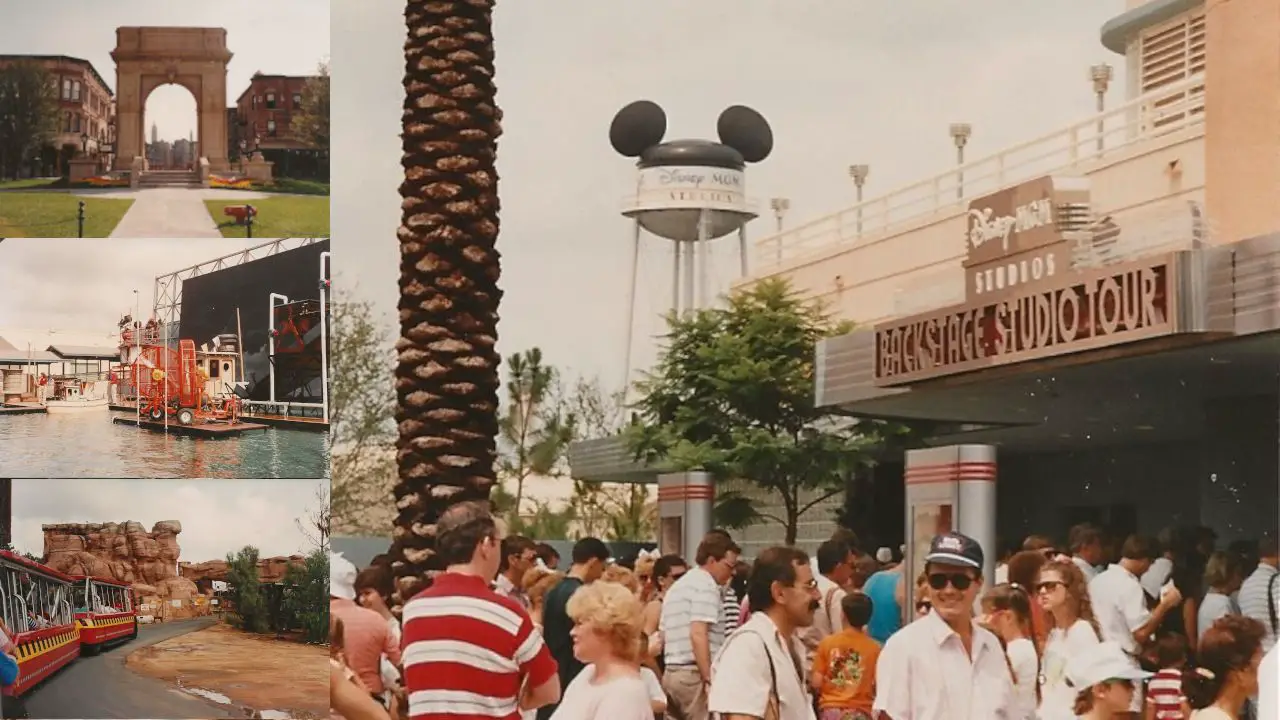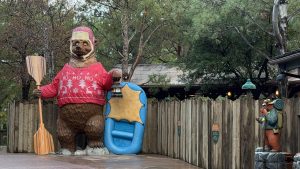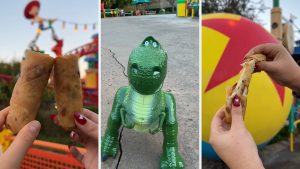
This year marks the 35th anniversary of the opening of the Disney-MGM Studios Theme Park (now Disney Hollywood Studios) in Florida. No other Disney park has gone through as much of a change, or has had as thorough a shift from its original guest experience as this one. Indeed, so swift were certain changes that some of its original attractions have fallen into the realm of near-legend. This certainly includes the Backstage Studio Tour.
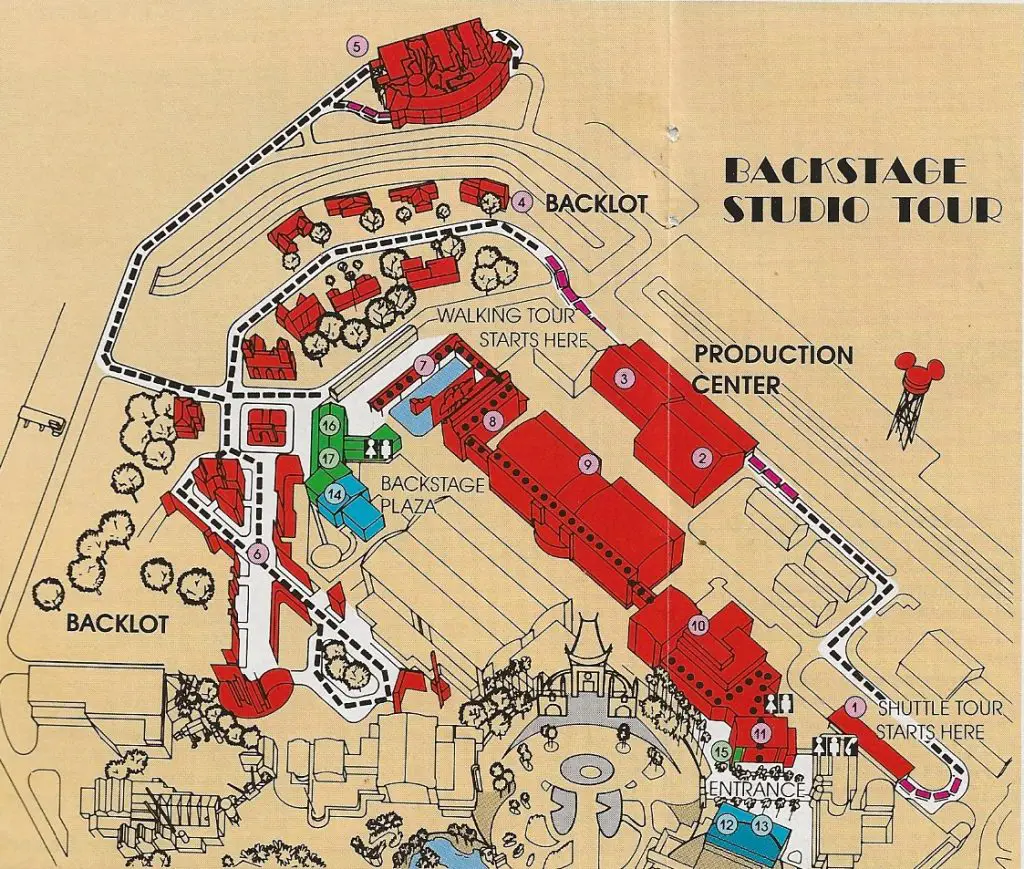
I remember the original tour quite vividly. I first experienced it in July of 1989, not long after the theme park’s grand opening that May. I experienced it again (and shot video) in September. By then changes had already been made, mostly to accommodate the large crowds that the relatively small park was attracting. The popularity of the park, and this tour in particular was reflected in an early tip sheet that recommended a variety of “time savers.”
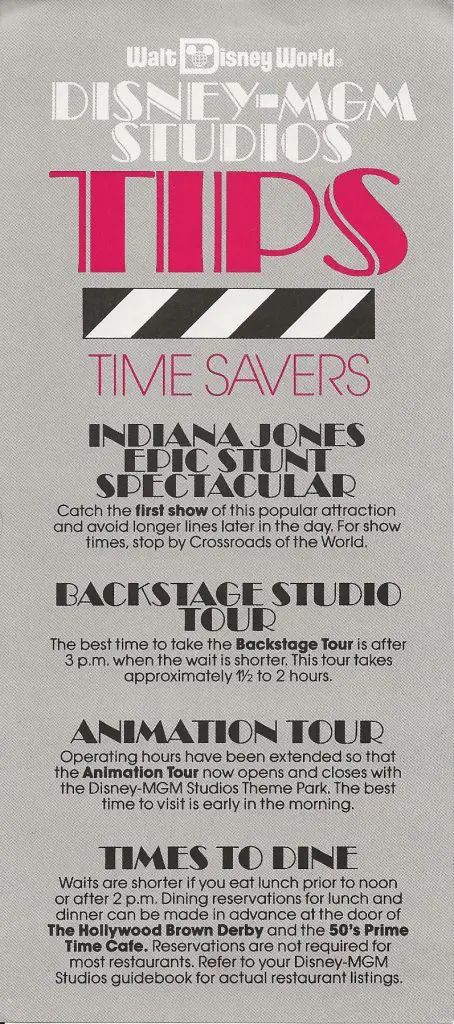
A Note: The images accompanying this article will consist of my own photos, as well as material drawn from original publicity and memorabilia. Some images are copyright 1989 by the Walt Disney Company.
The Disney-MGM Backstage Studio Tour was intended to be more than just a theme park simulation. It was promoted as a “working movie and television production center.” The park itself was built with a careful delineation between “Theme Park” and “Studio.” As an added attraction, Disney even included “a unique opportunity to visit Disney animators working on their newest featurettes.”
Let us, then, look at how this attraction was experienced in the opening months of the Disney-MGM Studios Theme Park.

The entrance to the Backstage Studio Tour was located to the right (roughly west) of the center of the park. A dedicated courtyard was accessed through an impressive gate, emblazoned with a sign reading Disney-MGM Studios and surmounted by a specially designed logo that combined MGM’s famous Leo the Lion and Disney’s own Mickey Mouse. This was intended to clearly separate the Studios from the theme park outside the gate.
Centered to the gate at the opposite side of the courtyard was a large building designed in streamlined moderne style, the prevailing architectural motif of the studios. A canopy jutted out from a pair of rounded pylons, flanking an open archway through the building. Across the leading edge of the canopy silver letters against a red background announced “Backstage Studio Tour.”

Once through this entrance, guests found themselves in a hidden switchback queue line. Video monitors and recorded announcements offered descriptions of the experience ahead. There were repeated notices that it could take up to two hours, with a break in the middle, after the first portion (a tram tour) and the second portion (a walking tour). Restrooms would be available only before the tour, during the break, and after.
With these admonitions ringing in their ears, guests eventually found themselves at the front of the queue, and ready to board the stylish studio trams. These red, black, and yellow liveried vehicles featured open sides and comfortable seats. Once full of guests, they pulled away and made an immediate, sharp U-turn to the left. The first part of the tour was the Front Lot (called the Production Center in Disney’s promotional material).

In 1989, the Front Lot was part of an actual working studio, with all the amenities that were required for production. As the trams rolled along, a host in the front car pointed out the various facilities. The first buildings in view were production bungalows, minor scaled office buildings clustered around a small, parklike campus. There were three buildings when the studio opened; within a year a fourth had been added.

Off to the right of the tram route was the famous “Earful Tower.” This water tower was really no more than a marquee, albeit a very special one, with massive Mickey “ears” added to the top. Also located along the right hand side of the tram route was a drainage canal, and a section of the “greens” department. The plants in this area changed frequently as various plants were brought in for use or to display at different times.

One memorable aspect of this tram tour was the indoor section, where the trams drove past working shops. A climate and light controlled shed allowed the trams to drive past the buildings on the left, as guests looked into the shops through plate glass windows. First up was a massive costume construction and storage shop. Small displays were spaced along the route with recognizable costumes from popular films. The first year, these consisted of “Big Business,” “Dick Tracy,” “Mary Poppins,” “Captain EO,” and “Who Framed Roger Rabbit.” Next in line were cameras, lighting, and props, as well as the working scene shop.

Leaving the Production Center and Front Lot, the trams emerged into the open air, drove past a small grove of trees, and took a left hand turn onto the Backlot. The first portion of the tour was Residential Street. Eight houses in a variety of architectural styles were arranged along the gently curving thoroughfare. The tour guide would point out the street’s only “permanent” resident, Herbie the Love Bug, now “re-tired” in front of Vern’s house from “Ernest Saves Christmas.” There were also oohs and aahs as the exterior of the house seen in “The Golden Girls” came into view. The guide would tactfully mention that the series was actually shot in Burbank, California.

Finally, at the end of the street, one of the houses could be seen fully “dressed out” with props, crew trucks, equipment, and even a Panavision camera in place on a tripod. There was never any mention of exactly what was being shot that day, and guests who made repeated visits (as I did) eventually realized that it was basically all for show. (I was later assured by a cast member that the camera was just an empty case.)

Next to the last house on Residential Street was a simple, white “small-town” church. As it was located on the corner leading into the “big-city” portion of the backlot, when we pulled forward the guide pointed out that the church had a more imposing brick facade around the corner. Before we got a better look at the rest of the standing outdoor sets, the tram took a couple of turns to the right, crossing over the drainage canal. To the right of the tram was a “boneyard” of vehicles and boats used in various films. In the earliest years these included cars and trucks from “Who Framed Roger Rabbit,” train cars from “Tough Guys,” a large keelboat from “The Treasure of Matecumbe,” and most memorably, the “hero” spaceship from “Flight of the Navigator,” sitting up on blocks in the Florida sunshine.
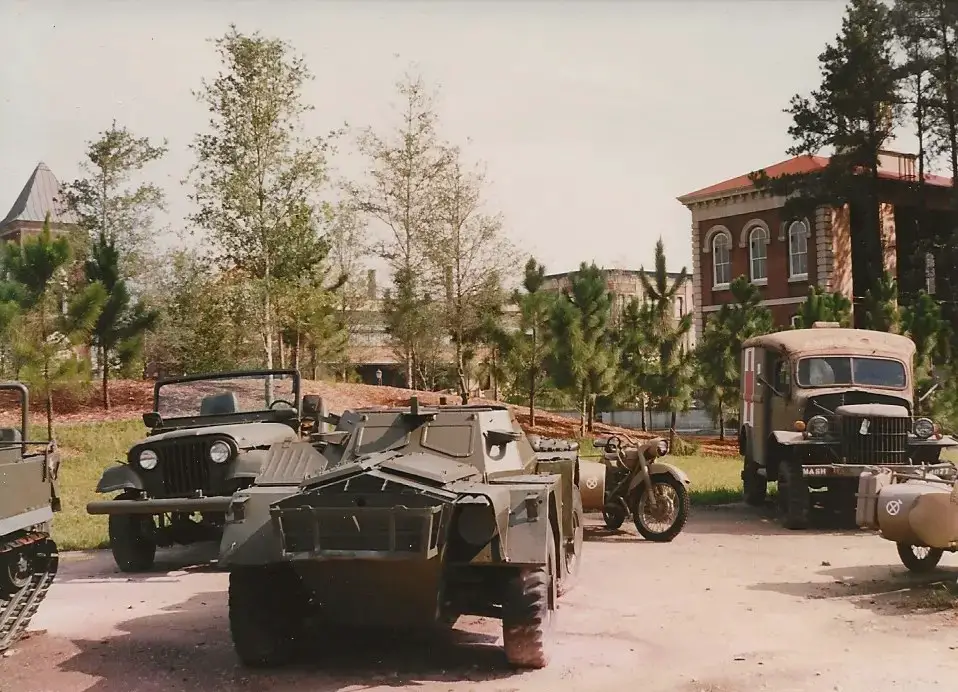
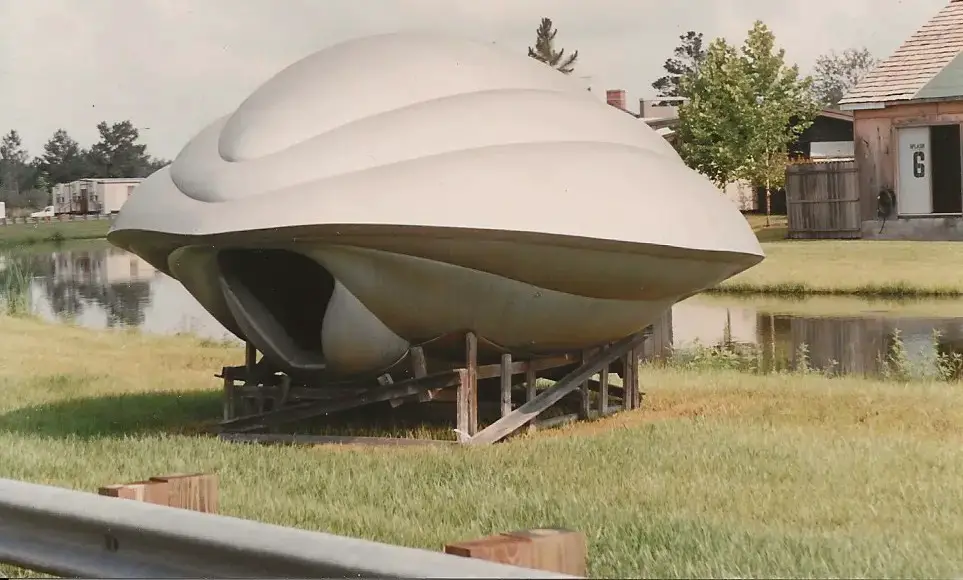
The reason for the lengthy trip away from the rest of the backlot soon came into view. It was a fairly large, open structure, surrounded by chain link fence and bristling with warning signs. As the gate itself was wide open, our guide assured us it couldn’t hurt to take a look at the largest standing “set” on the property, as long as the crew wasn’t actually shooting that day.

This was, of course, Catastrophe Canyon, a heavily promoted highlight of the Backstage Studio Tour. As the tram pulled forward into the secure area, guests were presented with an impressive panorama of southwestern style rocks and cliffs, complete with a working oil pump, storage tank, equipment and even a full sized tanker truck. Tour guides at this point had the choice of maintaining the fiction that we had accidentally wandered on to a “hot set” during production, or, more realistically, we were about to be treated to a demonstration of practical effects on a massive scale. Regardless, everyone kept their eyes trained on the left hand side of the tram, with cameras and video equipment ready.
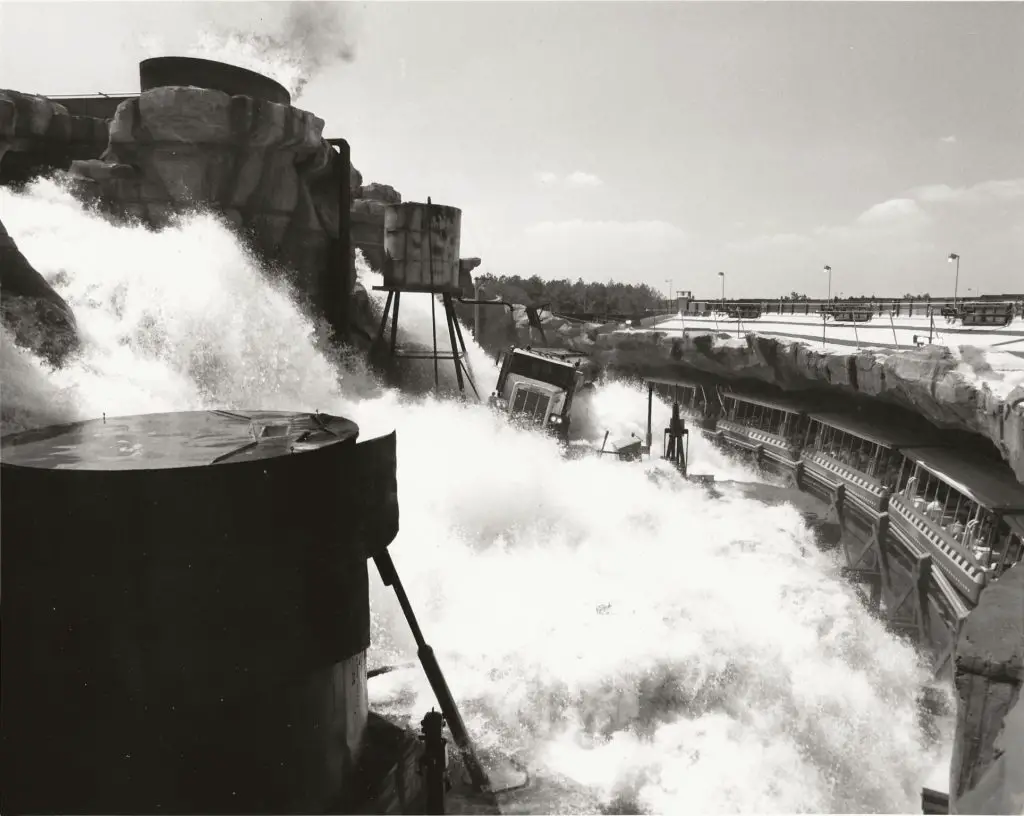
Once set into operation, Catastrophe Canyon for the most part was an unvarying experience. Only rarely were guests unable to enjoy the entire sequence. First, a hidden voice would announce “Catastrophe Canyon, scene one, take two,” and then call for rain. As rain fell from above and behind the tram, an earthquake would suddenly rattle the canyon. Flames erupted from the oil pump, the storage tank, and the tanker truck. A roaring sound then filled the air as the rain triggered a massive flood that cascaded down the walls of the canyon, toppling the tank and pushing the truck toward the tram. The grand climax saw a wall of water rush from above and behind the overhanging rock ledge which (thankfully) sheltered the tram and its occupants.
As the flames were extinguished and the last of the water drained away, the tanker truck and storage tank magically reset themselves. The tram would then spring back to life, pulling forward and to the left to offer a closeup view of the inner workings of Catastrophe Canyon. There was an impressive array of equipment, all clearly labeled and on view. Departing the massive set piece, it was likely one would see another tram, about to experience its own trial by fire and water.
The trip back covered the same ground, and once trams arrived back at the standing sets on the Backlot, the route could vary. Originally, pedestrians were not allowed onto New York Street or any of the area where crews could be filming. During those early weeks, as the trams entered the urban area, they would make a right hand turn, with Washington Square to the left and an imposing municipal building on the right. Halfway down New York Street the tram would veer to the left, and head toward a warehouse where the Dipmobile from “Who Framed Roger Rabbit” was parked. After a loop around a triangular planted area, the trams would cross New York Street and continue up Brownstone Street. Following another right turn, it was a left turn next to the park (now on the right of the tram), and another right to avoid heading back onto Residential Street.


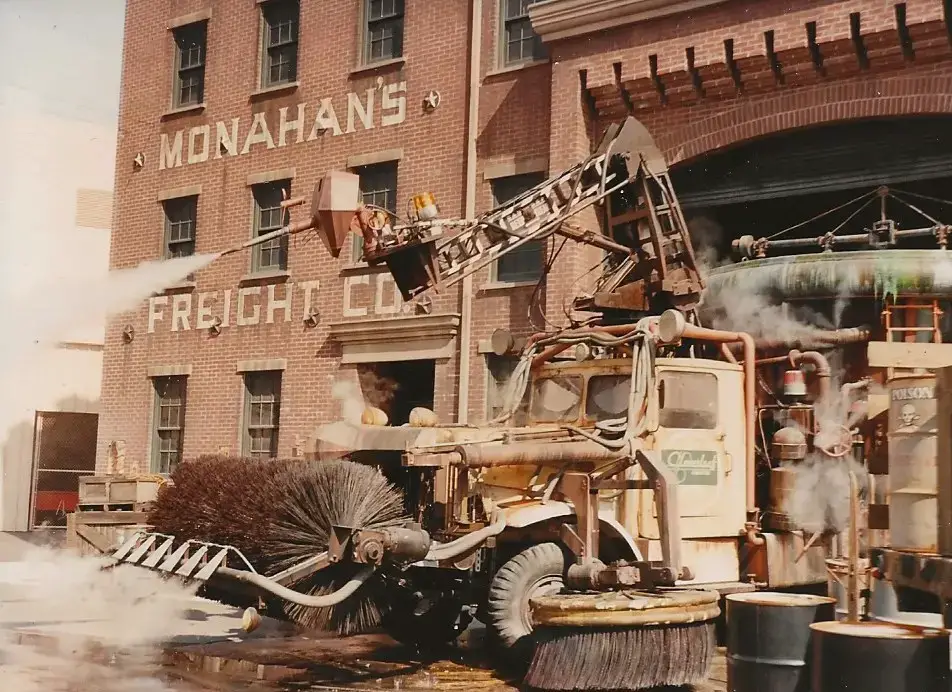
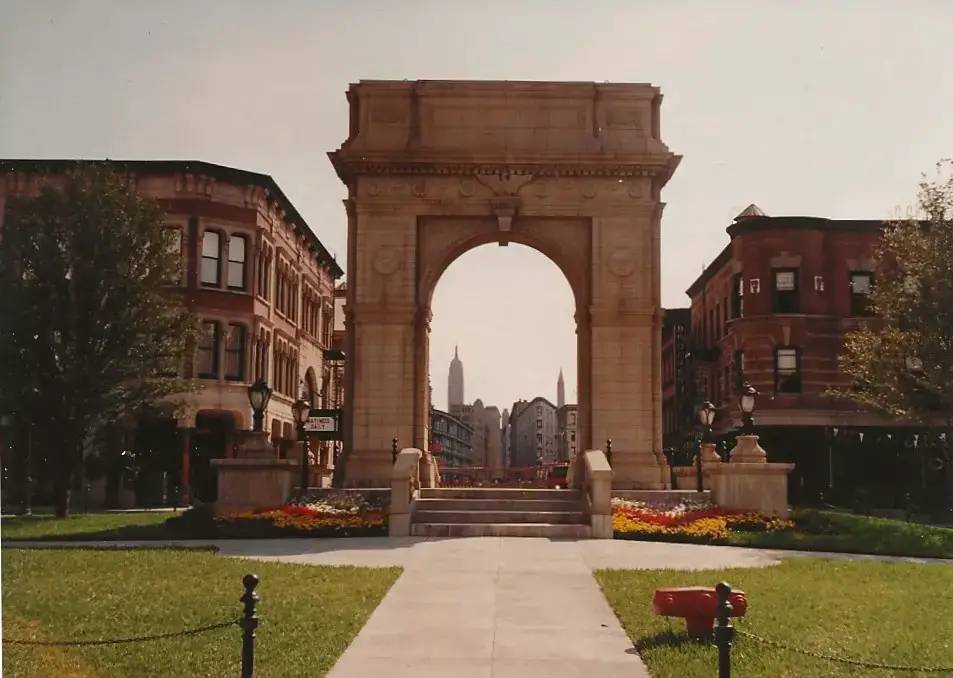
On the way out, trams would pass between the church and Washington Square Arch, as the guide pointed out how the arch perfectly framed the shot of the forced perspective street. Then it was around the corner to the left and the tram unloading station. Guests were informed they were now at Backstage Plaza, the halfway point in the tour.

Backstage Plaza was something of a hodgepodge. It was built as a gathering spot before guests continued on to the walking portion of the Backstage Studio Tour. In addition to the aforementioned restrooms, there were also two shops and a casual dining location.
The Studio Catering Company was there to offer little more than a fortifying snack or drink. Fruit salads, ice cream, light snacks and beverages were the official offerings. The Disney Studio Store offered memorabilia from Walt Disney Studios and Touchstone Pictures. In 1989, Disney had not yet acquired the staggering array of intellectual properties they draw on today.
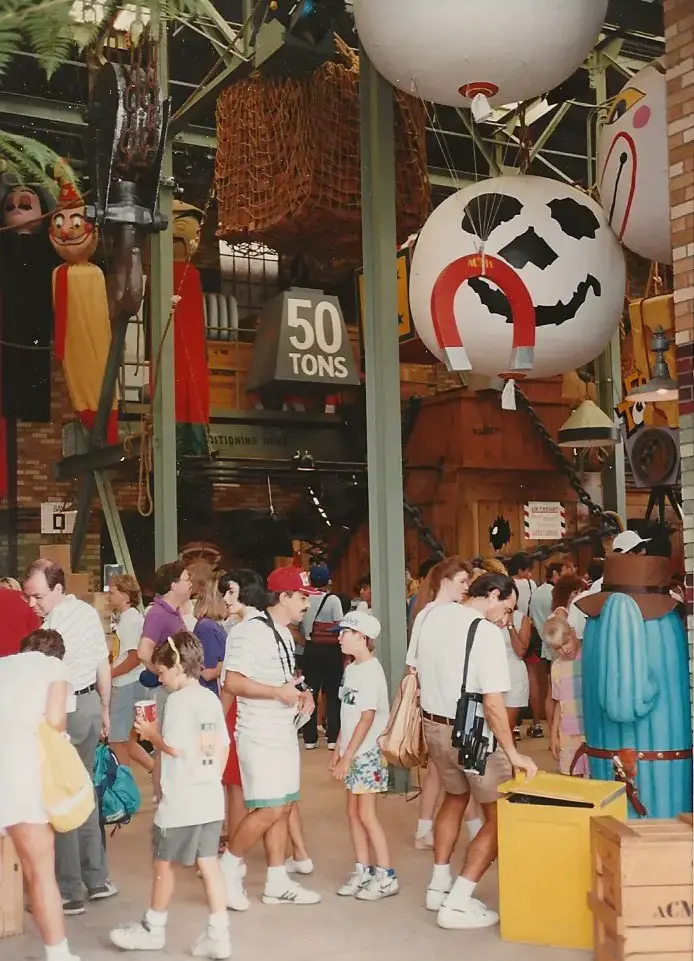
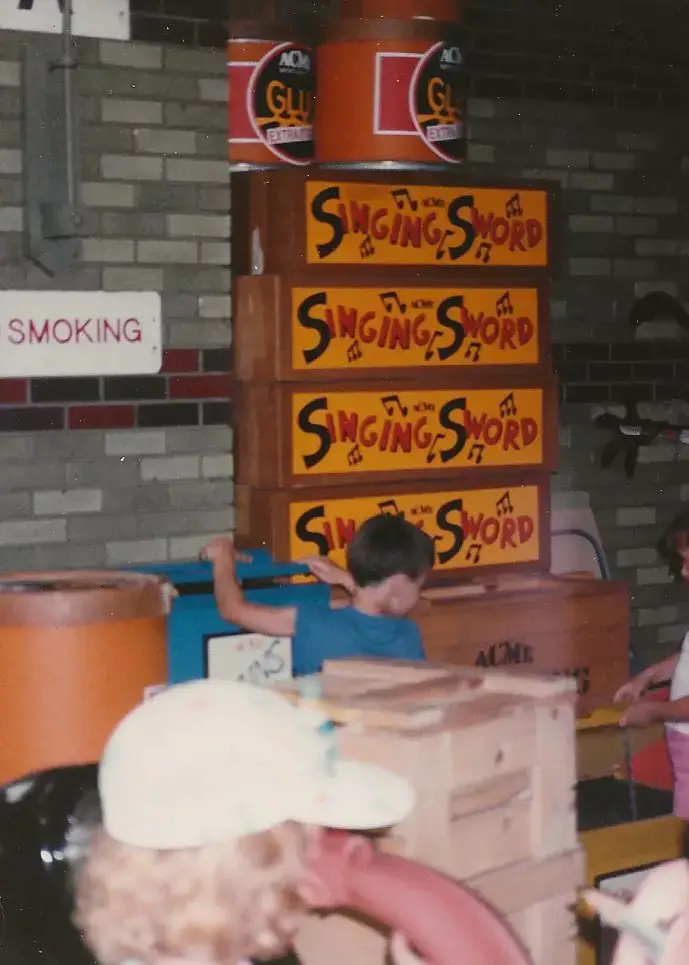
The largest store, by far, was the Loony Bin. This was a large venue that seemed to encompass the entire area. The theming, based on “Who Framed Roger Rabbit,” was reinforced by the presence of actual props and set pieces that had been delivered directly from the Disney Studio soundstages (although guests were unaware of this fact). By far the most dumbfounding aspect of the Loony Bin was the presence of a number of licensed products from the Warner Brothers studios. I was not the only guest to wonder just how it could be that Daffy Duck, Sylvester the Cat, and the Tasmanian Devil were sharing shelf and display space with Mickey, Minnie and the rest of the gang.
There was also an area called Foto Toons, although it seems to have been part of the Loony Bin. Within a matter of weeks this area was expanded with the addition of Toon Park and access to portions of New York Street (later called the Streets of America, and today Grand Avenue). One memorable experience that was not part of the original Backstage Plaza was the Honey I Shrunk the Kids play area. This was a major addition that appeared during a later expansion.
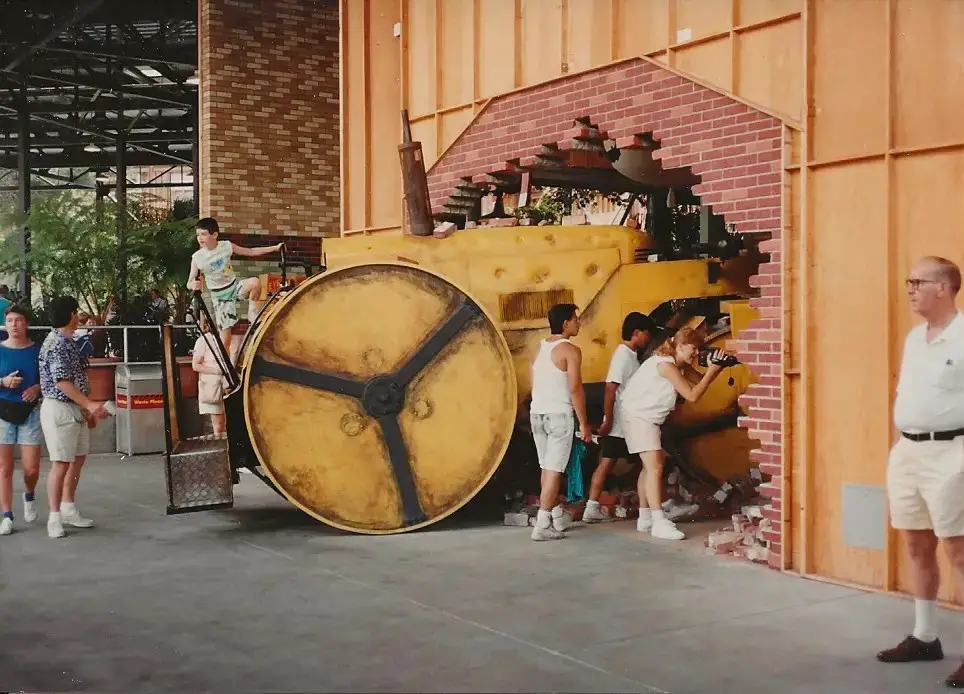

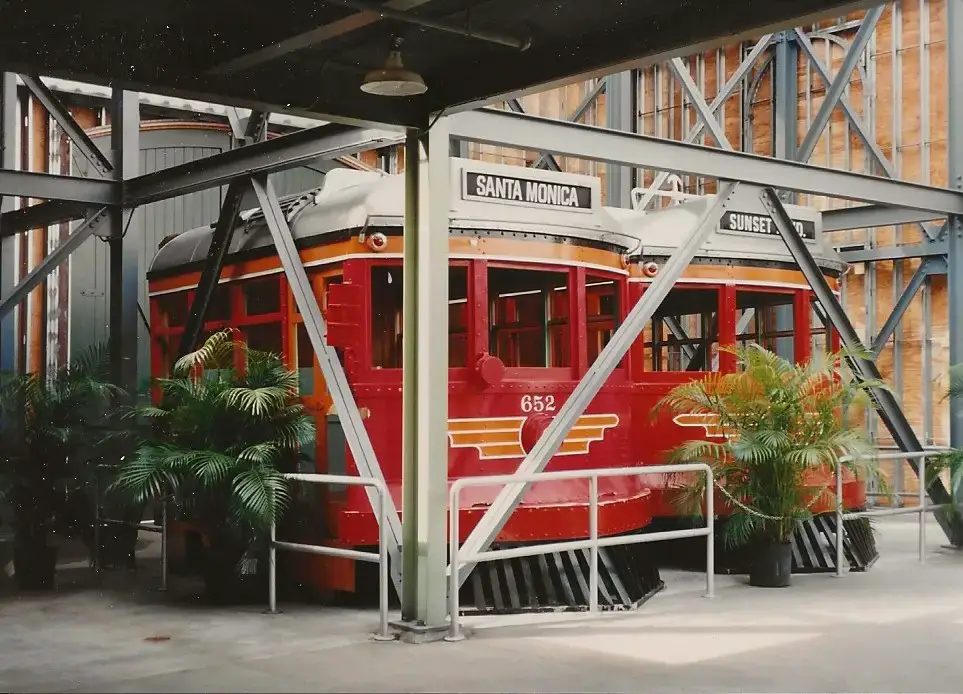
Time to get back to the tour! After downing a light snack, stopping off at the restroom, and buying a plush Tweety Bird, guests were directed to the walking portion.
As is true for any Disney theme park attraction, the walking potion of the Backstage Studio Tour first involved a switchback queue line. In this one, overhead monitors offered humorous vignettes about different aspects of the special shooting effects that would be demonstrated on the tour. Stars like Goldie Hawn, Rick Moranis, Mel Gibson and Peewee Herman starred in these brief films. Guests could also view and take photos of a series of movie cars parked along the outside edge of the queue.
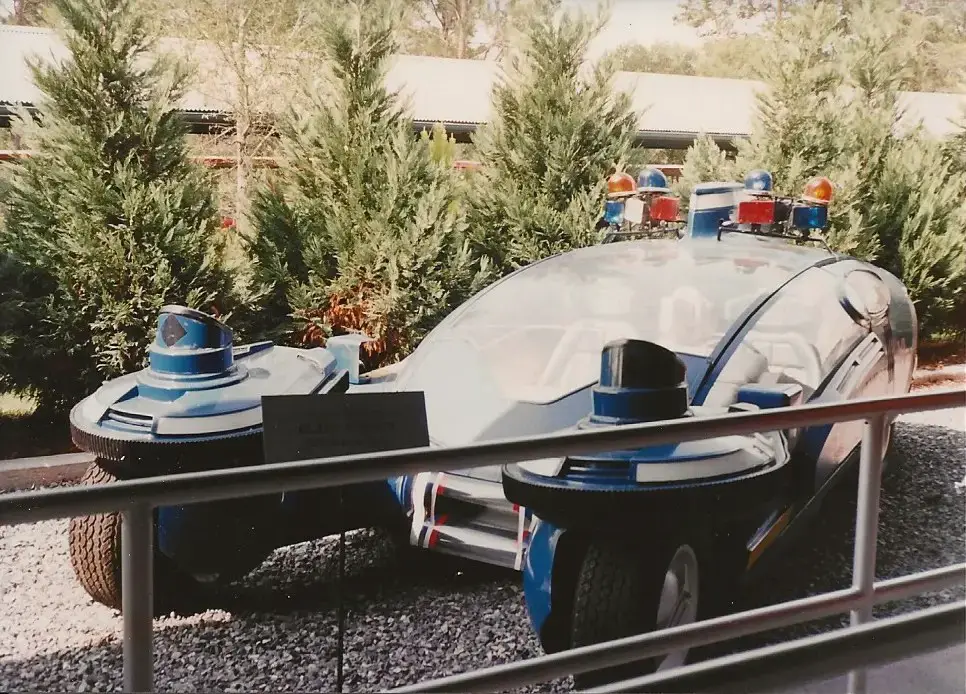
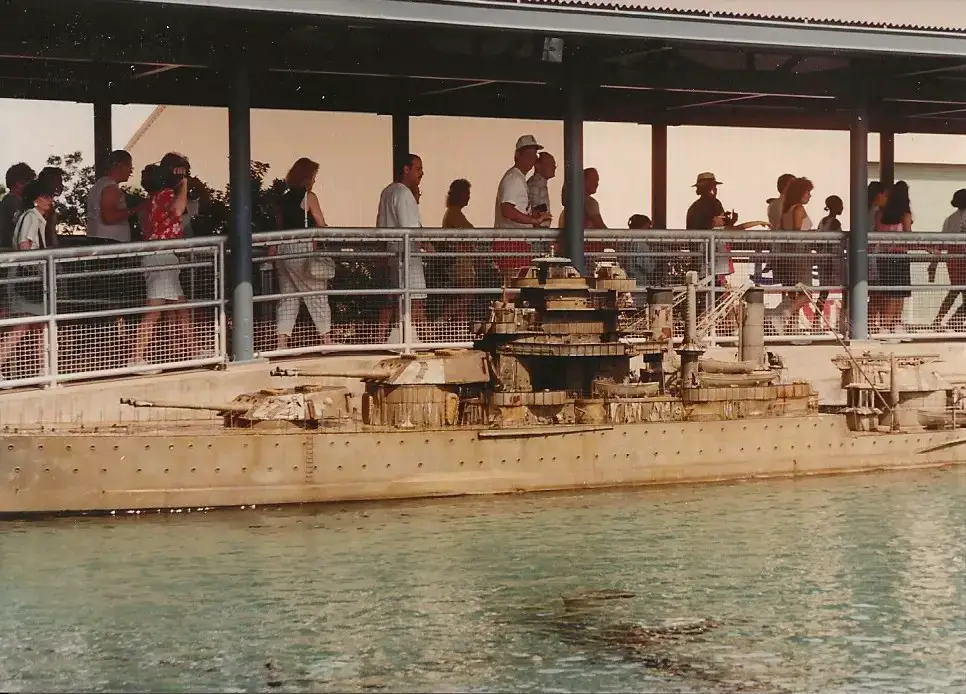
The first stop for the walking tour was the Water Effects Tank. This consisted of a large, shallow pool, surrounded on two sides by a shaded viewing area. Catwalks ringed the tank, and some highly detailed miniature ships were tucked into the corners. A set piece representing the cabin of a small ship (the “Miss Fortune”) was placed next to a “dump tank” full of water. A large backdrop depicting stormy skies completed the scene.

Guests were first treated to some pyrotechnics, including water cannons and fire effects. The highlight of the Water Effects Tank was a demonstration using an audience volunteer. Clad in a slicker and rain hat, the guest was placed behind a ship’s wheel in the cabin set piece. As it slowly rocked back and forth, the audience counted down to trigger the dump tank, which inundated the cabin. An instant playback presented the scene in closeup, intercut with footage of a matching miniature ship, fighting stormy seas and succumbing to a massive wave.

The rest of the walking tour took guests indoors. First, there was a look at mechanical effects, in the special effects workshop. As a host explained how these mechanical and practical devices could be utilized, some of them would come alive in humorous or alarming ways. The climax of the demonstration was a full-scale cacophony as all the devices began operating at once.
Continuing their walk along dedicated catwalks that ringed the perimeter of each room, guests were next shown how the blue-screen process worked. For this demonstration, two children were selected and carefully strapped onto the back and side of a set piece representing a giant bee. As the set piece rocked and tilted, a computer controlled camera swept past, as the children were coached to alternately flail their arms and hang on for dear life.

Another instant playback intercut this footage with a section of the film “Honey I Shrunk the Kids,” a scene in which Rick Moranis attempted to swat a wildly zooming bee with a baseball bat. After the last shot of the volunteers had filled the screen, there was a quick cut to a familiar theater balcony. Seated in it were Roger Ebert and Gene Siskel (stars of Buena Vista’s “Siskel and Ebert and the Movies”). The dueling critics came to a swift disagreement about the effectiveness of the blue screen footage, but did agree that the kids deserved two thumbs up.
After passing through special effects and the shooting stage, it was time to look at some actual soundstages. In 1989, the Disney-MGM Studios had two stages. One was fully occupied by the “The All New Mickey Mouse Club,” which debuted in August, 1989. The walking tour took guests along a glass enclosed visitor’s gallery, where it was possible to look down into the stage. Whenever anything was in production, guests were forbidden to operate cameras or recording devices of any kind.
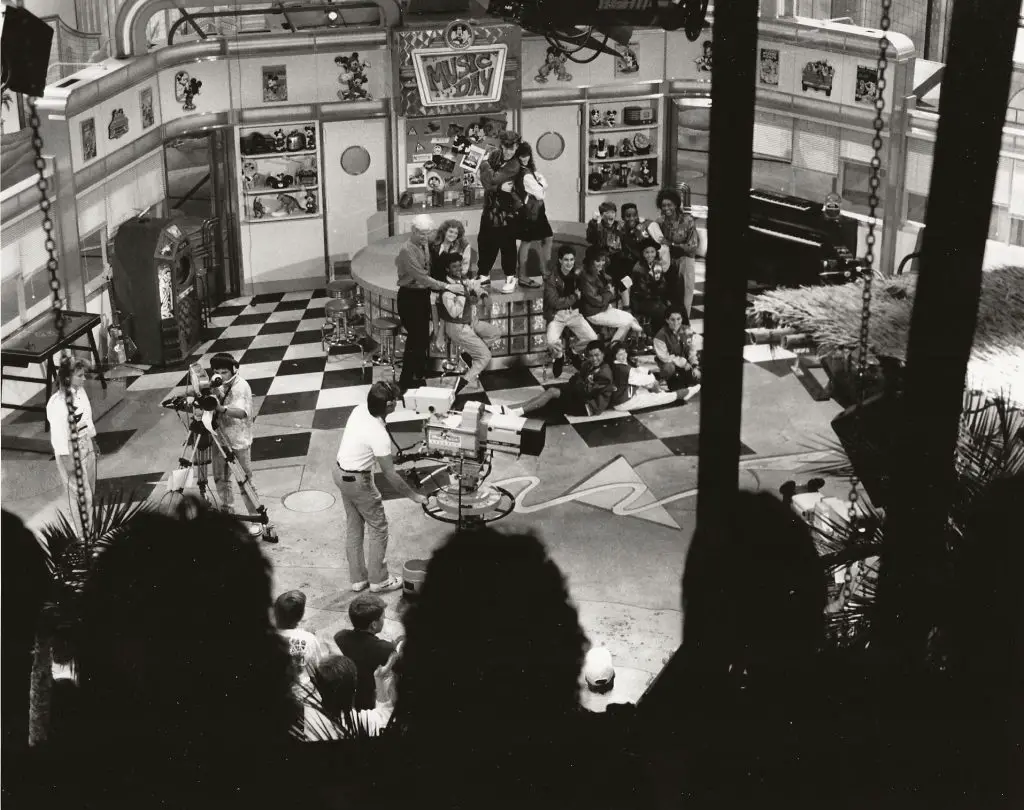
The final section of the walking tour encompassed post production editing and audio. Through videos, the process of bringing all the elements of filmmaking together were explained. Guests were then treated to a three minute long film, “The Lottery,” starring Bette Midler and directed by Garry Marshall (who had a cameo role in the production). In “The Lottery,” Midler played a hapless singing teacher who wins a $17 million dollar lottery, only to have her winning ticket carried off by a pigeon. All ends happily, but not before a wild chase through the streets of Disney’s New York.
This was actually the first production shot entirely at the Disney-MGM Studios. Over 100 crew members utilized all of the techniques detailed in the earlier portions of the tour. Afterward, another video showed how these techniques had been used, and the tour concluded with a walk past many of the sets and props used in the production.
As a reward for completing the Backstage Studio Tour, guests were offered a sneak preview of upcoming Disney Studio productions in the Walt Disney Theater. For the first year, and several thereafter, a humorous short film featuring Michael Eisner and Mickey Mouse preceded the screening. In it, we learned that Michael Eisner wore a Mickey Mouse watch, and Mickey wore a Michael Eisner watch! Exiting the Walt Disney Theater, guests found themselves back in the Disney-MGM Studios courtyard.
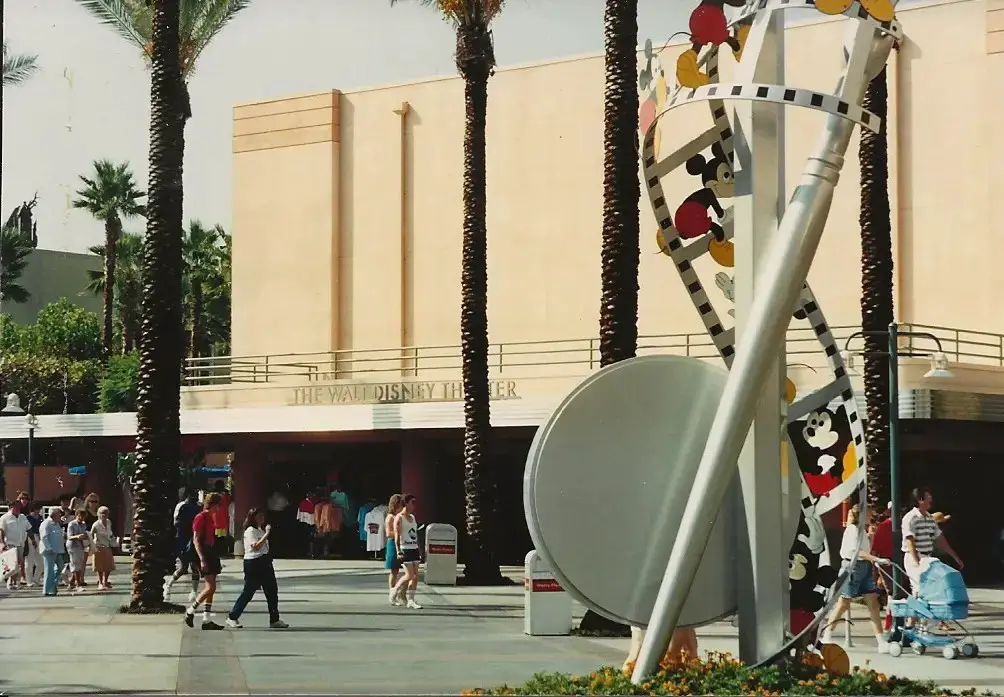
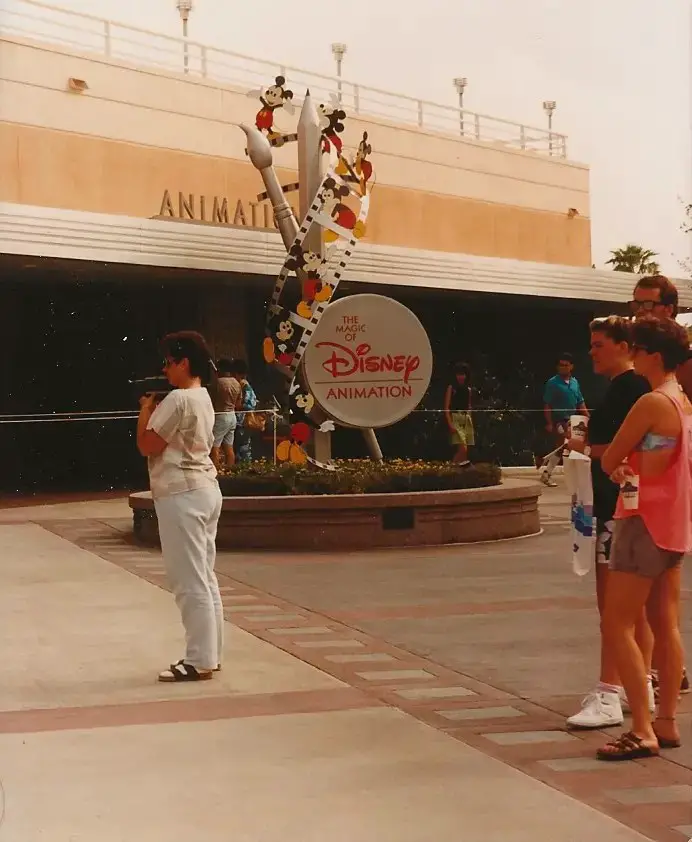
The Backstage Studio Tour was not the only attraction offered to guests that opening year of the Disney-MGM Studios. Next door to the tram entrance was another tour called the Magic of Disney Animation. This was a shorter walking tour through a working animation studio, established as a satellite production facility to Disney Animation in Burbank.

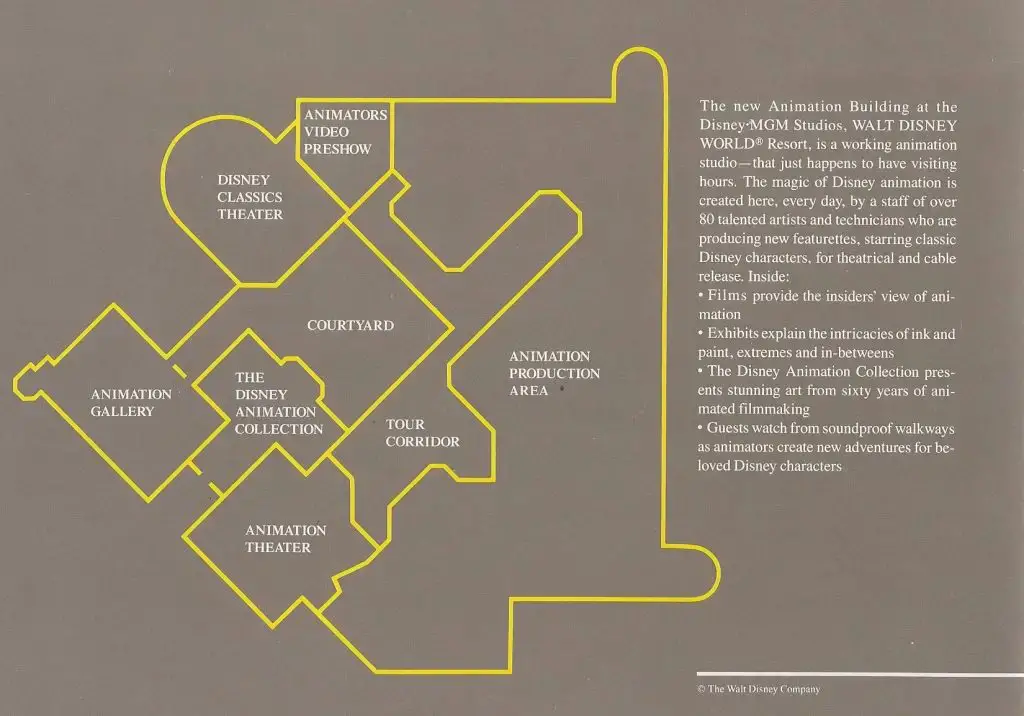
The entrance to The Magic of Disney Animation was marked by a unique three dimensional sculpture in which a pencil, a brush, and film intertwined, with multiple Mickeys climbing to the top. Inside the lobby was a display of classic animation cels and backgrounds. The tour began in a small theater with a screening of a specially produced animated film, “Back to Neverland,” starring the unlikely duo of Walter Cronkite and Robin Williams. In it, Cronkite talked Williams through the steps of creating an animated film, and in the process placed him in a new adventure with the Lost Boys and Captain Hook.
Following the film, guests were ushered into a raised gallery where they could see animators working on each of the steps they had just seen: Story, Animation, Clean Up, Effects, Backgrounds, Photocopying Process, Paint Lab, Inking and Painting, Animation Camera, and Editing.
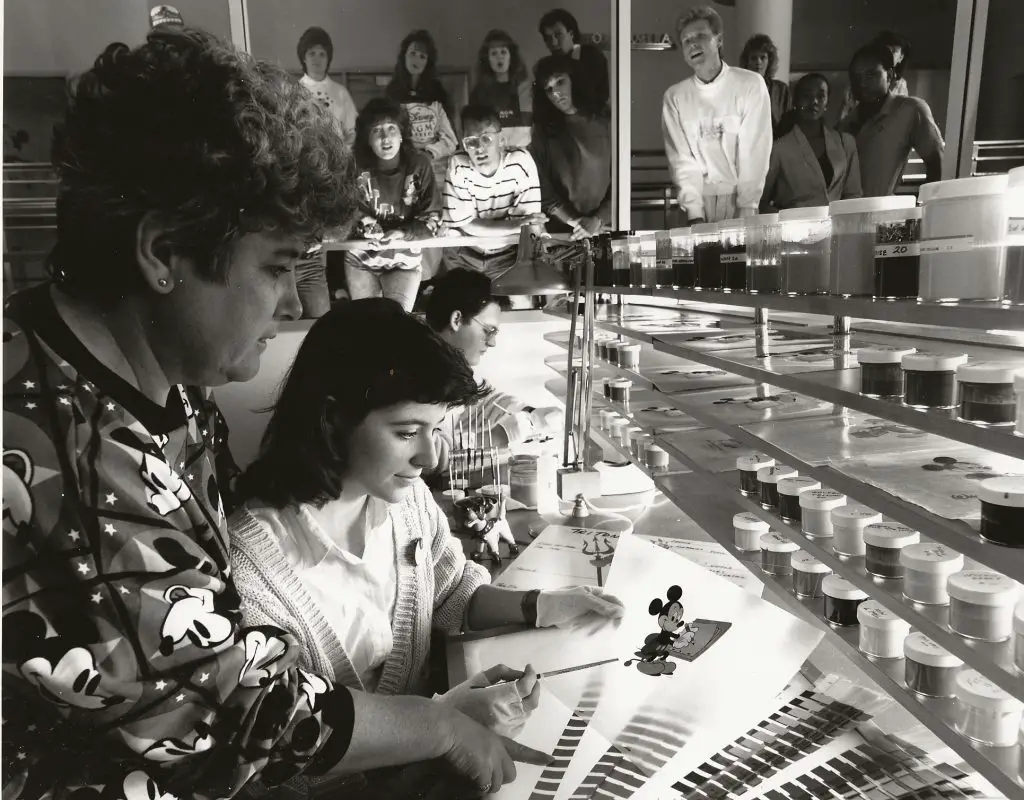
This was a more leisurely tour, and guests could linger if they desired. The finale of the visit was another small theater where a compilation of magical moments from classic animated Disney films was presented. On the way out there was, of course, a gift shop, the Animation Gallery.
The Backstage Tour and Animation Tour were intended to be the centerpiece of the Disney-MGM Studios. Great care was taken to provide access to every aspect of the film and television process. Because the Studios park was an immediate hit, these tours were very crowded throughout the day. The small footprint of the entire park led to some quick decisions about expanding public areas to absorb the crowds.
The first big change was opening sections of the backlot and rerouting the tram tour. Seeing guests wandering through the restricted sections of the park made it harder for people to accept the concept that this was a working studio. Some things were added quickly and stayed longer than anyone may have anticipated. Others were added without considering the impact on the clear separation of public and working areas. With the final demolition or repurposing of all production elements for such attractions as Lights! Motors! Action! and themed areas such as Galaxy’s Edge and Toy Story Land, there was no longer any need for that separation.
That is why today, most visitors do not even realize that Disney Hollywood Studios was ever anything other than a theme park.

